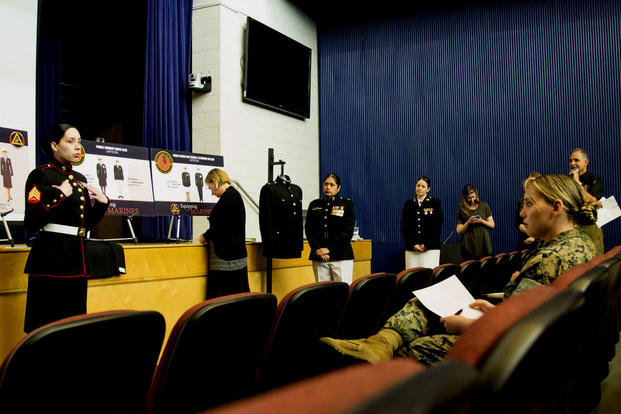In 2013, the Marine Corps began quietly testing a new look for female Marines at Marine Barracks Washington: a dress blues coat featuring a high "Mandarin collar" like that on the male uniform, rather than the winged blazer-style collar on the traditional female uniform.
The Barracks, which hosts many dress occasions, including formal events and parades, eventually adopted male-style covers and jackets for female Marines on the parade field.
But the Corps has been conducting wear tests and surveys ever since to determine whether to take the look to the force.
Later this month, the service will wrap up a survey that solicits feedback from female Marines on changes to a modified dress blues coat that is similar to the men's, but contains subtle style and tailoring adjustments.
The survey, which is taking place in person at specific locations and online, is at least the third of its kind, as fine-tuning continues on the coat.
The new survey began at the initiative of Marine Corps Commandant Gen. Robert Neller, said a defense official with knowledge of conversations about the uniform change.
The initial push for new dress uniform items began under Gen. Jim Amos, a previous commandant, and Neller expressed interest in evaluating the move before making a change.
"When Gen. Neller became commandant, he said, 'Wait, is this what our females really want?' " the official said.
At the time, then-Navy Secretary Ray Mabus was beginning a slew of initiatives designed to make female Marines and sailors look more like their male counterparts, a move he saw as a way to bring greater equality to the force.
But the efforts weren't well received by all.
In the Navy, where dress uniforms and covers were changing to become more unisex, some sailors complained that the changes were costly, unnecessary and unpopular.
"Female Navy officers now had to foot the bill to buy a uniform item they loathed to replace a uniform item they loved," Andrea Goldstein, who served as an active-duty naval officer until 2016, wrote in an editorial for Task and Purpose.
In another Task and Purpose editorial from 2015, two female Marine officers, Maj. Nicole V. Bastian and Capt. Mabel Annunziata, protested changes to the female dress blue coat as a misplaced effort to make men and women more equal in the service.
"The initiative to change the uniform is wrought with gender bias, and in essence tells female Marines that only through what a Marine wears in formal ceremonies will she be recognized as an equal member," they wrote. "The dress blue coat currently worn by women is identifiable as a Marine uniform to the public and proudly symbolizes not just women's achievements on the field of battle, but also the long road to equality attained by women through integration and opportunity."
In January and February 2015, months before Neller would become commandant that September, the Corps conducted a similar online and in-person survey for both a prototype dress blues coat in the male style, and dress cover with a round frame like that worn by men, instead of the narrower female style.
The survey, according to a Marine Corps announcement, was designed to determine best fit and form for both items.
Ultimately, the service adopted a unisex dress cover, requiring all female Marines to own the new uniform item by May of this year.
But as Marine Corps Times reported in early 2016, reviews on the coat were mixed.
According to data obtained by the publication, three out of five Marines liked the new unisex style, but those in the more senior officer and enlisted ranks were less keen on the look, with roughly 50 percent preferring to keep the old coat.
In January 2016, the Marine Corps Uniform Board voted to adopt the modified female dress blue coat as a replacement for the current one, but noted that prototype refinement still had to take place, and it would likely be two to three years before the coat was ready to field.
Information about when female Marines are required to own the new coat has yet to be published.
The design that female Marines are being surveyed on features modifications from the traditional men's coat.
According to Barb Hamby, a spokeswoman for Marine Corps Systems Command, the changes include a Mandarin-style collar 1/4-inch shorter than that on the male coat, a form-fitting waist with a white belt and waist plate for the enlisted-style coat, and no pockets.
The male dress blue coat has both waist pockets and breast pockets.
Hamby said the design in its current form was finalized in 2015.
"The design led to prototypes and a deliberate series of engagements with female Marines through onsite and online surveys and focus groups, which began last spring," she said. "...The surveys are expected to conclude Sept. 22. The results of the surveys will go to Marine Corps officials for final adjudication and submittal for approval."
During a meeting last April between service officials and female Marines from around the National Capitol Region to discuss changing the coat, leaders stressed that feedback mattered at this stage.
"I think our commandant takes this very seriously, hearing each and every Marine, particularly in a decision like this that is going to be long-standing, or potentially long-standing," said Sgt. Maj. Edward Parsons, sergeant major for Headquarters and Service Battalion at Henderson Hall, according to a Marine Corps news release.
"Our commandant wants to hear what our women Marines have to say about it. If they like it, I think he's going to take it into consideration. If they don't like it, I truly believe he's going to take that into consideration," Parsons said.
-- Hope Hodge Seck can be reached at hope.seck@military.com. Follow her on Twitter at @HopeSeck.





























